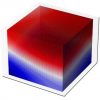Objectives: Understanding and familiarization with the basic elements of energy systems, their thermodynamic and design approach and related basic calculations.
Contour:
- Basic Thermodynamics 1. Tables of properties of vapors and ideal gases, properties of gas mixtures, 1st and 2nd Law of Thermodynamics, enthalpy, internal energy and entropy.
- Basic Thermodynamics 2. Isentropic and real elementary devices (nozzles, diffusers, valves, compressors and pumps, turbines, ducts, heat exchangers).
- Basic Thermodynamics 3. Heat engines (Otto, Diesel, Sterling Brayton and Rankine cycles), techniques to increase the energy efficiency of real heat engines.
- Basic Thermodynamics 4. Refrigerators and heat pumps, design, dimensioning, variable load operation.
- Basic Fluid Mechanics. Bernoulli equation, pumps, head of pumps, cavitation effect, single- and two-phase flow in pipelines.
- Turbines 1. Analysis of gear triangles of pumps and water turbines.
- Turbines 2. Triangular analysis of compressors, turbines and wind turbines.
- Electrical Arrangements. Elements of electric circuits, generators, accumulators and power electronics.
- Heat. Design of heat exchangers, cogeneration and district heating.
- Fuel cells. Fundamentals of electrochemistry, types of fuel cells, overvoltage, power curve, efficiency, losses and fuel usage.
- Combustion. Fuel characterization and calorific value, excess air, combustion, burner technologies, losses, efficiency and boiler technologies.
- Sustainability analysis data. Present value of future cash flows, investment costs, annual operating costs, depreciation, borrowing costs, investment viability criteria.
- Introduction to RES. Energy balances, RES potential, RES penetration, the 20-20-20 Directive, National Action Plans for RES, legislation.
